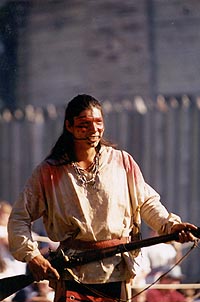 Reenactor at the 1997 Fall Encampment at Fort Massac, Metropolis, Illinois
Reenactor at the 1997 Fall Encampment at Fort Massac, Metropolis, Illinois
|
Coming Soon!
Books on Indians
of Southern Illinois
|
|
|
|
|
Indians of Southern Illinois
|
|
— Prehistoric Indians —
|
|
- Cahokia Mounds
- What we call Cahokia Mounds once served as the cultural center of the Mississippian
civilization. Today the site is administered by the Illinois Historic Preservation Agency
and is listed as a World Heritage Site by the United Nations.
- Fountaim Bluff Solar Observatory
- Jim Jung describes the evidence in favor of a Mississippian-era solar observatory on the west side of Fountain Bluff in southwestern Jackson County. Jung is one of the editors of the Waterman and Hill Traveler's Companion nature almanacs for Southern Illinois.
- Piasa Bird
- John J. Dunphy breaks down the legend of Alton's famed Piasa Bird to show the underlying
myth of this so-called Indian legend. Nevertheless he still supports repainting the creature
on the bluffs upriver from Alton as a testement to the original painting placed their by
prehistoric Indians. The online page for Pere Marquette State Park provides the traditional legend
.
- Stoneforts and Rock Art
- There are a number of prehistoric native archaeological sites involving stone walls and detailed rock
art. The two local leading researchers are husband and wife. This is a news story from a presentation they
made on their hypotheses.
|
|
— Historic Indian Culture —
|
|
- Cherokee Trail of Tears
- The northern overland route of the Trail of Tears entered Southern Illinois at Golconda and traveled
westerly through Vienna and Jonesboro - generally parallel to what's now Illinois Route 146.
Also check out what Rev. Butrick's diary of the trip across Egypt. For an
overview of the trail story check out
Burnett's story.
This Cape Girardeau-based site
also has more on local trail stories from Southern Illinois and southeast Missouri.
- Illini Indians
- Robert Fester's site covers the basics of what is known about the confederacy of
Indians that gave Illinois its name. Another site gives a more detailed history of the
Illinois Indians. The Illinois State Museum has another
concise history.
- Kaskaskia Indians
- This is the Catholic Encyclopedia article on the Kaskaskias, one of the tribes that made
up the Illinois Confederacy.
- Shawnee Indians
- The Shawnee, or Shawanoe, Indians never made Southern Illinois a major permanent home, but
various smaller groups of that band had various campgrounds and some villages in the region.
A village on the Ohio River a few miles below the mouth of the Wabash River
from 1745 to 1747 gave the name Shawanoe Town, later Shawneetown, to the county seat of Gallatin County.
The Shawnee entry for Hodge's Handbook also provides a detailed account of the tribe.
- Tecumseh
- This great Shawnee chieftain visited Southern Illinois in 1811.
- Winnebago War
- The Winnebago War of 1827 is Illinois' (really more of Wisconsin's) most forgetable military
action. This excerpt of Gov. Thomas' Ford's, "A History of Illinois" tells the story of the
war as well as how Illinoisan's became known as "Suckers."
|
|
— Indian Massacres —
|
|
- McMahan Family Massacre
- Taking place in 1795, this raid in what is now Monroe County left most of Robert McMahan's family dead with him and his daughter captured.
- Mound City Massacre
- The Mound City Massacre took place on February 9, 1813, and remains one of the worst Indian attacks in Southern Illinois history. It also served as the ignition point for the Creek War, a frontier sidebar to the War of 1812.
- Wood River Massacre
- This 1814 raid during the War of 1812 left a mother and six children dead in Madison County.
|
|
— Archeaology News —
|
|
|
|
 Reenactor at the 1997 Fall Encampment at Fort Massac, Metropolis, Illinois
Reenactor at the 1997 Fall Encampment at Fort Massac, Metropolis, Illinois
